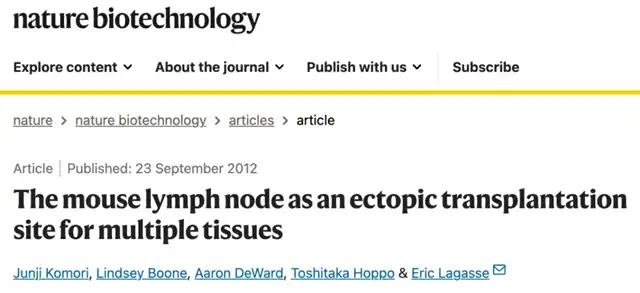Human Body Grows Second Liver by Injecting Liver Cells into Lymph Nodes
- Normal Liver Cells Found to Promote Cancer Metastasis to the Liver
- Nearly 80% Complete Remission: Breakthrough in ADC Anti-Tumor Treatment
- Vaccination Against Common Diseases May Prevent Dementia!
- New Alzheimer’s Disease (AD) Diagnosis and Staging Criteria
- Breakthrough in Alzheimer’s Disease: New Nasal Spray Halts Cognitive Decline by Targeting Toxic Protein
- Can the Tap Water at the Paris Olympics be Drunk Directly?
Human Body Grows Second Liver by Injecting Liver Cells into Lymph Nodes
- Should China be held legally responsible for the US’s $18 trillion COVID losses?
- CT Radiation Exposure Linked to Blood Cancer in Children and Adolescents
- FDA has mandated a top-level black box warning for all marketed CAR-T therapies
- Can people with high blood pressure eat peanuts?
- What is the difference between dopamine and dobutamine?
- How long can the patient live after heart stent surgery?
Human Body Grows Second Liver by Injecting Liver Cells into Lymph Nodes
12 years after the publication of a groundbreaking paper, it’s now a reality! Injecting 50 million liver cells into lymph nodes has grown a second liver inside the human body.
On April 2, 2024, LyGenesis announced that the first patient in the 2a phase clinical trial of its First in Class allogeneic regeneration cell therapy has been dosed. The therapy involves injecting liver cells from healthy donors into the lymph nodes of patients’ upper abdomen, where “mini livers” grow to treat end-stage liver disease (ESLD).
The clinical trial, approved by the FDA in 2020, will not only evaluate the therapy’s safety, survival time, and post-treatment quality of life for patients but also help determine the ideal number of “mini livers” needed to stabilize patients’ health. Currently, the first group of treated patients will receive injections of 50 million liver cells into a single lymph node. If proven safe, the second group will receive a total of 150 million cells injected into three lymph nodes, and the third group will receive 250 million cells injected into five lymph nodes.
The company aims to recruit 12 patients with end-stage liver disease for the 2b clinical trial by mid-2025, with each treated patient undergoing close monitoring through follow-up for a year to examine the safety, tolerability, and efficacy of transplanted allogeneic liver cells. The clinical trial results will be announced in 2026.
Dr. Michael Hufford, co-founder and CEO of LyGenesis, stated, “For the first time in a clinical trial, we are using a patient’s own lymph nodes as a living bioreactor to regenerate ectopic organs. This could be a milestone in regenerative medicine, helping end-stage liver disease patients grow new functional ectopic livers within their own bodies. If successful and approved by the FDA, this therapy could allow us to treat dozens of end-stage liver disease patients with one donated liver, helping to address the current organ supply-demand imbalance and benefit more patients.”
As early as 2012, Professor Eric Lagasse’s team at the University of Pittsburgh School of Medicine published a paper in Nature Biotechnology confirming that lymph nodes can support the implantation and growth of healthy cells from multiple tissues. Injecting liver cells into the lymph nodes of mice was enough to produce sufficient ectopic livers and save mice with fatal metabolic diseases. Injecting islet cells into the lymph nodes of mice restored their normal blood sugar control.

Since then, Professor Eric Lagasse and others founded LyGenesis, focusing on developing a novel cell therapy platform that uses a patient’s own lymph nodes as bioreactors to grow functional ectopic organs. LyGenesis’ ongoing projects include generating ectopic livers (for treating end-stage liver disease), ectopic thymus (for anti-aging), ectopic pancreas (for treating type 1 diabetes), and ectopic kidneys (for treating kidney diseases).
Professor Eric Lagasse stated that directly injecting healthy donor liver cells into a patient’s liver would not survive, while lymph nodes could serve as potential sites for new liver growth. These bean-shaped tissues, as part of the immune system, help resist infection, have the ability to expand, and filter blood like the liver. Importantly, adults have 500-600 lymph nodes, converting one or a few of them for other purposes would not greatly affect the overall function of lymph nodes.
Previous studies in pigs have shown that for pigs with liver failure, injecting healthy liver cells into their lymph nodes resulted in the formation of “mini livers” within two months, with a cell structure similar to that of a healthy liver. The research team also found bile-transporting cells (bile is a digestive fluid produced by the liver) in the “mini livers.” In addition, they did not observe accumulation of bile acids, indicating that the “mini livers” were processing bile.
These “mini livers” only reach 10%-30% of the liver mass, which is enough to have a meaningful impact on patients with end-stage liver disease. However, it is still unclear how large these “mini livers” will grow in the human lymph nodes. Dr. Michael Hufford, co-founder and CEO of LyGenesis, stated that there is reason to believe that these mini-organs will not grow indefinitely in the lymph nodes. These “mini livers” rely on chemical distress signals from the failing liver to grow. Once the newly grown “mini livers” can filter blood stably, they will stop growing because the distress signals disappear.
These “mini livers” do not solve all the complications of end-stage liver disease. LyGenesis hopes it will serve as a stopgap measure, helping patients with end-stage liver disease to wait for suitable liver transplant donors or improve their health to be eligible for liver transplantation.
If this clinical study is successful, it is worth further exploring whether it can be used with the patient’s own cells.
Human Body Grows Second Liver by Injecting Liver Cells into Lymph Nodes
References:
1. https://www.nature.com/articles/nbt.2379
2. https://www.science.org/doi/10.1126/sciadv.aaz9974
3. https://gut.bmj.com/content/early/2022/01/06/gutjnl-2021-325018
4. https://www.nature.com/articles/d41586-024-00975-z
(source:internet, reference only)
Disclaimer of medicaltrend.org
Important Note: The information provided is for informational purposes only and should not be considered as medical advice.



